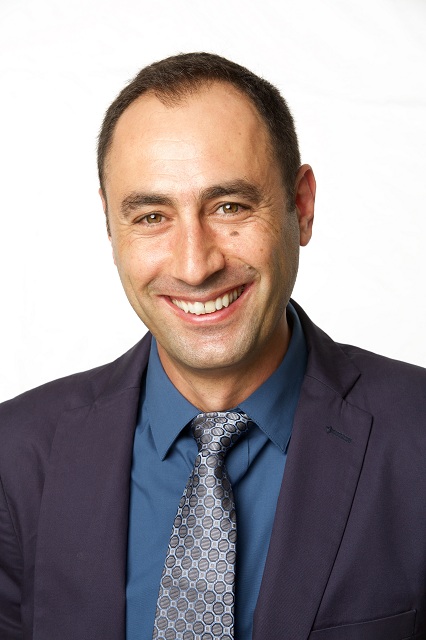
Elias Aboutanios
- Senior Lecturer
- Deputy Director of the Australian Centre for Space Engineering Research (ACSER)
- Director of the Masters in Satellite Systems Engineering
- School of Electrical Engineering and Telecommunications
- Phone: +61 2 9385 5010. Fax: +61 2 9385 5993. Email: elias@ieee.org
Education
- PhD in Electrical Engineering, University of Technology, Sydney, completed in October 2002
- Bachelor of Electrical Engineering with first class honours, the University of New South Wales, 1997
- Certificate III in Electrical Wiring, Southern Sydney Institute of TAFE, 1997
- Higher school certificate, Sydney Technical High school, 1992
Highlights
- Recipient of an Australian Space Research Program (ASRP) grant (over $1M - $675,000 external and $349,000 from Consortium) and project leader of the Warrawal Project to develop Australia’s first masters program in satellite systems engineering.
- Project leader for the UNSW contribution (UNSW-ECO) to the QB50 Project to launch 50 cubesats to low earth orbit (secured $250k in funding for the project).
- Academic Mentor for BLUEsat Project (secured in excess of 75k funding for the project over 3 years).
- Over 70 publications including 20 Journal publications, 49 Conference papers, 4 news articles, and a patent on frequency estimation.
- Lead guest editor for a special issue of the EURASIP Journal on Advances in Signal processing on Biologically Inspired Signal Processing (published December 2010).
- Recipient of the 2014 Excellence in Postgraduate Research Supervision Award.
- Recipient of the UNSW Faculty of Engineering Teaching Excellence Award, 2011.
- Best paper award at the CISP'10-BMEI'10 conference held in Yantai, china, for the paper titled “Instantaneous Frequency based Spectral Analysis of Nuclear Magnetic Spectroscopy Data”.
- Invited articles in IEEE Instrumentations and Measurements Magazine (published April 2011), and special issue on New Trends in Signal Processing and Biomedical Engineering.
- Invited presentations on the ASRP project at the Australian Space Science Conference (2011, 2012, 2013).
- Invited presentations at the University of Athens (2010), University of Adelaide (2005).
- Presentations at UNSW (2006) and the National ICT Australia (2005), Surrey University (1999), and NASA Glenn research centre (2000).
- Session chair and program committee member for a number of conferences, including DSP’2011, CISP’2010, DSP’2009.
- Reviewer of the third edition of the Principles of Space Time Adaptive Processing book by Richard Kelmm.
- IEEE Member since 1998, Senior Member since 2011, member of the IEEE Signal Processing Society, former representative of the IEEE Power Society in the GOLD affinity group, councillor of the UNSW IEEE student branch.
- Reviewer for IEEE transactions on Signal Processing, Transactions on Communications and other technical journals.
- Recipient of Australian Postgraduate Award with stipend, 1998-2001.
- Bachelor of Electrical Engineering with first class honours (distinction average of 82.5) from the University of New South Wales (UNSW).
- Sydney Electricity (later EnergyAustralia, and now Ausgrid) scholarship, 1994 – 1997, UNSW Co-op scholarship, 1993 – 1994.
- Higher school certificate in 1992, with a Tertiary Entrance Rank of 99.5.
- Fluency in English, Arabic, French, and Spanish.
Employment History
February 2007 – Present; Senior Lecturer, The University of New South Wales
Staff member of the School of Electrical Engineering and Telecommunications with responsibilities in research, teaching, and administrations:
Research: My research activities are primarily in signal processing and satellite systems with additional work in engineering education. My research in signal processing covers the following areas: radar target detection, global positioning systems and navigation systems, nuclear magnetic resonance spectroscopy, Bio-sonar (primarily the study of bat echolocation calls), and image processing. I have established ongoing collaborations with researchers at The Universities of Edinburgh, Cambridge and Athens, and most recently I have established a research collaboration with Prof. Moeness Amin from Villanova University (this collaboration has resulted in an MOU being signed with Villanova Uni). Locally I have strong collaborations with researchers at the UNSW NMR facility as well as the School of the Built Environment. I am a member of the Australian Centre of Space Engineering Research (ACSER). I established Australia’s only Masters program in Satellite Systems Engineering (with over $1M in funding), which I am currently running. I have also established and lead UNSW’s contribution to the QB50 project (UNSW’s satellite is called UNSW-EC0 and the project has a budget of $250k). I also supervise the BLUEsat team’s Stratospheric Balloon Launch activities and am developing this capability at UNSW. I conduct research into various aspects of satellite engineering for cubesats including structures, on-board computing, and constellation design. I have designed and established the Space Systems Laboratory within the School of Electrical Engineering and Telecommunications. I am currently supervising six PhD students.
Teaching: I have taught a number of diverse areas including signal and image processing (both at the undergraduate and postgraduate levels), ethics, and Design. My teaching experience also covers small, medium and large classes. In 2009 I started developing the 4th year undergraduate Design Proficiency subject including setting its teaching philosophy, aims and method of delivery. This subject is unique in the degree as it aims to test the students on their ability to function as professional engineers at a stage where they are quite close to their graduation. The delivery method of the course is innovative and covers both individual and teamwork. The novelty of the subject has allowed me to carry out research into the professional education of our graduates and I am in the process of preparing a number of publications on the topic. I have received the Faculty of Engineering Teaching Excellence Award for this course. I am involved in high school open days and have developed a successful demonstration of signal processing concepts to high school students (years 10-12). This work has led to a conference publication. I have also established the Masters of Satellite Systems Engineering Program. This worked involved setting the program aims and objectives, graduate attributes and learning outcomes. We then developed the program’s structure and a number of the courses. The entire program was developed and introduced in just under two years. It is currently running.
Administration: Since joining the school I have been heavily involved in various committees and been responsible for a number of administrative duties. I served as the chair of the Services and Finance committee that allocates funding for strategic expenditure in the school. I have proposed, designed and built a dedicated hardware laboratory for our undergraduate students and have obtained funding for and acquired hardware for the undergraduate teaching labs. I have also been regularly involved in various events and committees, such as the history book launch committee. I am the academic advisor for the BLUESat team and the IEEE UNSW student branch councillor. I am been involved in the high school open days during which I run a signal processing demonstration where we measure gravity using sound waves. I run the Satellite Masters Program and serve on the Engineering Faculty’s scholarship committee.
Funding: I have recently led a team that secured over $1M for the development of the first Australian masters program in Satellite Systems Engineering. The project consortium comprised Thales-Alenia Space, ISAE and Optus in addition to UNSW. The funding consisted of $675,000 from the ASRP and $349,000 from the consortium members. The in-kind contributions of the consortium members amounted to over $1.5M. Additionally, I obtained $5000 of internal funding to develop the grant proposal. In 2012 I received a further $230,000 to establish the QB50 project. In 2010, I secured $8,500 for a learning and teaching grant to develop an introductory course in satellite systems which laid the foundation for the ASRP grant. I also have received a faculty research grant (FRG) of $25,000 in 2010, and another FRG of $25,500 in 2008.
October 2003 – February 2007; Research Fellow, University of Edinburgh
Member of the Signals and Systems Group. Mainly conducting Research in Space-Time Adaptive Processing (STAP) for airborne radar. I was part of the BAE strategic alliance team that includes four PhD students in addition to Professor Bernard Mulgrew. My research and work activities included:
- Research in STAP for ‘difficult’ radar target detection in the monostatic radar context in heterogeneous environments
- Collaboration with one of the PhD students on clutter suppression for bistatic STAP
- Assistance in the supervision of the remaining three PhD students
- Master’s student supervision (one in 2005 and one in 2006. In addition, I am assisting one of the PhD students in the supervision of a master’s student)
- Guest lecturing, tutoring and lab demonstrating
- Work on the BIAS (Biologically Inspired Acoustic Systems) project
- Collaboration with Dr Keith Willey (then at UNSW) on low data rate acquisition using low earth orbit satellites
July 1999 – September 2003; Part time academic, UTS
During this period, I undertook a number of teaching duties, including lecturing, tutoring, laboratory supervision, and marking. I was involved in the Signal Processing, Signals and Systems, Introduction to Electrical Engineering, and Uncertainties and Risks in Engineering subjects. I also carried out academic work for the school of Electrical Engineering and Telecommunications at the University of New South Wales.
July 2002 – October 2002; C++ programmer, CRCSS, UTS
I worked as a Visual C++ programmer on the FedSat Ka band earth station. My tasks included:
- Writing the earth station spatial utility software. This software consists of a graphical user interface (GUI) that allows the earth station operator to convert raw GPS orbital data to antenna pointing angles.
- Programming the large screen display which shows the satellite’s position in real time over the map of Australia.
February 1998 – April 2002; University of Technology, Sydney
I was a member of the Cooperative Research Centre for Satellite Systems (CRCSS) team. In addition to my PhD research, I had the unique opportunity to carry out engineering work on the project. My responsibilities primarily included the frequency acquisition and tracking of the UTS Ka band earth station and I was heavily involved in the DSP implementation of the spatial and frequency acquisition. I contributed to the writing, debugging, and optimisation of the software both in C++ and assembly. I was also involved in the specification and design of various components of the communications payload for the FedSat satellite.
January 1997 – June 2001; Graduate Engineer, EnergyAustralia
In 1997, I joined EnergyAustralia as a graduate engineer on their career rotation program. I spent two periods of six months each at the communications section and the Geographical Information Section. In 1998, I obtained leave and enrolled into the PhD program at UTS. During the next three years, I completed two eight-week long work placements at the Environmental Section and TCA respectively. My responsibilities during this four year period were varied and included:
- Implementation of a GUI for the EMS2000. The EMS2000 is a device that monitors energy consumption for the purposes of improving a customer’s energy profile.
- Investigating the protection of underground high voltage cables against termite attack.
- Programming and technical support (in the ARC/INFO package) for staff at the Geographical Information Section.
- Investigation of the relative merits of the GRN (Government Radio Network) and public mobile phone network as a communications system for field staff.
PhD Topics Available
For more information click here or contact me.
Professional Profiles
News (updated January 19, 2017)
UNSW-EC0 launch is now scheduled for 16 March as part of the Cygnus OA7 resuply mission to the ISS. The launch will take place from Cape Canaveral on an Atlas V rocket. Follow us on Facebook and Twitter.
Paper titled "Rapid Accurate Frequency Estimation of Multiple Resolved Exponentials in Noise" published in Signal Processing.
Paper titled "Recent Advances in Indoor Localization: A Survey on Theoretical Approaches and Applications" published in IEEE Communications Surveys and Tutorials.
Paper titled "Fast Iterative Interpolated Beamforming for Accurate Single Snapshot DOA Estimation" Accepted for publication in IEEE Geoscience and Remote Sensing Letters.


